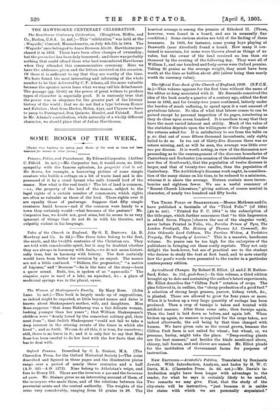Agricultural Changes. By Robert H. Elliot. (J. and J. H.
Ruther- ford, Kelso. 3s. Ild., pOst-free.)—In this volume, a third edition brought up to date and containing the author's latest experiments, Mr. Elliot describes the "Clifton Park" rotation of crops. The plan followed is, in outline, the "cheap production of a good turf." A selection of strong large grasses, yarrow, kidney vetch, &c., is planted. These are allowed to grow for four years or more. When it is broken up a very large quantity of rootage has been produced. Then a crop of turnips is taken and treated with artificial manure. After these come oats; then turnips again. Then the land is laid down as before, and again left. When broken up again, no manure is required for the crops taken, nor indeed afterwards, the soil being by that time charged with humus. We have given oats as the cereal grown, because the Clifton Park farm is not suited for wheat; but wheat, or, we presume, barley, might take the place. "Deep-rooting plants are the best manure," and besides the kinds mentioned above, chicory, tall fescue, and red clover are named. Mr. Elliot pleads for the institution of Government farms for purposes of instruction.










































 Previous page
Previous page